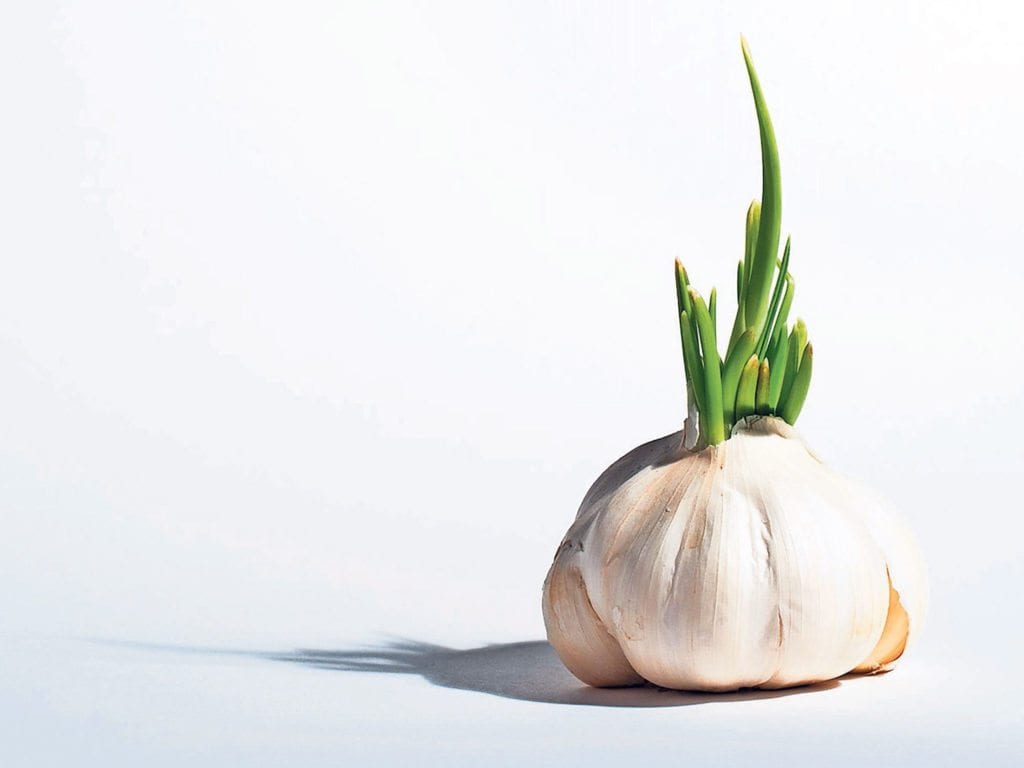
As the ides of April grow near, garlic lovers across the Northern Hemisphere find themselves facing a similar sight: green sprouts forming in our cloves.
Like the shared bond of financial bloodletting that American wage earners endure at roughly the same time, the sprouting of the garlic signals a change in one’s wealth status, regardless of the race, gender or socioeconomic status of the individual garlic eater. In the same way that taxes take a bite out of one’s net worth, the annual sprouting of the garlic is our cue that the garlic stash will soon be cashed.
This should matter to all eaters of garlic, and not just the growers and hoarders. Until further notice: If you purchase garlic, prepare to purchase sprouted garlic.
This latitude-wide response to spring signals that the end is sight. The cloves will grow steadily softer in the coming weeks, shriveling as the little plant diverts energy from the clove (which is a actually a leaf modified into a storage organ) to the shoot that’s forming in its core, and will soon emerge from the tip.
A true delicacy
Most cooks dig out that sprout; a common refrain is that the green part adds bitterness. But that practice never sat well with me, in part because I consider sprouts, in general, to be delicacies in the purest sense of the word: The growing tip of a plant is often the most delicate form of that plant. In many cases, such as bamboo, asparagus or ferns, the shoot form is the only part that is edible.
It’s springtime, after all, and sprouts are everywhere. Horsetails by the creek, weed sprouts in the garden. Everything I think I know about botany and nutrition and flavor makes me believe that garlic sprouts will be good.
Props to blogger Jill McKeever, one of the few to share my view, who writes, “… the bite of garlic that hits your palate is unmistakably garlic but it doesn’t hang long, compared to eating a fresh garlic clove that will stay with you for hours.”
Thanks to my new research, I’ve come back around to what most cooks do when confronted by that green sprout staring up from the cutting board: Slice open the clove and remove the sprout. But maybe I do it more carefully than most, because it’s the sprout I want. And I want it intact. Except the scabby part, or the area above it. Thanks to my research I now trim higher off the bottom once the clove has sprouted.
This time of year, the white part of the garlic holds down the traditional garlic tasks (as long is they are crispy enough to chop), while the mild green sprouts can be used in playful, beautiful and delicious ways, similar to how scapes can be prepared. Chinese-style with pork and oyster sauce, for example, or slowly browned in butter, on toast.
Growing garlic
Alas, like death and taxes, the decline of garlic is inevitable this time of year. Especially if you identify with the shriveling white part, rather than the waxing green shoot, bursting with vigor.
But if you can shift gears and focus on the sprout, on the other hand, the party is only getting started. And depending on how much sprouting garlic one has on one’s hands, one can either prepare a tasty treat and be done with it, or get to work. One option is put your sprouts in a place where they can grow.
The cloves can be planted in pots, or in the newly thawed garden. They won’t develop subterranean bulbs like they would have had you planted them last fall, but they will grow lots of spicy foliage that you can use when you’re low on the white stuff. For the land-poor, McKeever suggests placing your sprouting bulb in a dish with a little water and setting it on a windowsill.
As they grow, use your garlic sprouts like they are chives, scallions or other spicy sprouts. Chop and sprinkle the spicy, pungent greenery wherever you wish. But unlike those onion-y shoots, garlic shoots are less hollow in the middle and have more bulk. It’s more asparagus-like, and can be prepared as such, in long spears, in the pan or steamer. Just don’t burn it. That’s the only way a properly trimmed garlic sprout should taste bitter.






